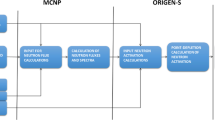Abstract
Typically, the concentrations of cobalt and europium, which are trace elements in concrete, are difficult to determine by chemical analysis. While data sheets do not usually contain this information, it is important for the decommissioning of accelerators, especially for the decontamination of activated concrete. To understand the variations in trace element concentrations in concrete, we analyzed cobalt and europium concentrations in concrete samples from accelerator facilities in Japan by neutron activation analysis, which is suitable for trace element analysis on the order of parts per million (ppm).




Similar content being viewed by others
References
Masumoto K (2009) Decommissioning of accelerator facility—example of the tanashi branch. J RANDEC 39:30–43
Matsumura H, Toyoda A, Yoshida G et al (2018) In-situ determination of residual specific activity in activated concrete walls of a PET-cyclotron room. J Phys Conf Ser 1046:0120016
Matsumura H, Yoshida G, Toyoda A, et al. (2019) Simplified method for determining residual specific activity in activated concrete of a PET-cyclotron room using a survey meter. In: Environmental radiochemical analysis VI, pp 135-147
Suzuki A, Iida T, Moriizumi J et al (2001) Trace elements with large activation cross section in concrete materials in Japan. J Nucl Sci Technol 38:542–550
Toyoda A, Matsumura H, Masumoto K, et al. (2019) Quantitative evaluation of radioactivity in concrete at PET cyclotron facility with simple and nondestructive measurement. Environmental radiochemical analysis VI, pp 178–183
Oyama T, Hagiwara M, Nakamura H et al (2020) Thermal neutron profile inside J-PARC main ring tunnel. Nucl Instrum Methods Phys Res A937:98–106
Nishikawa K, Miura T, Hagiwara M, et al. (2020) Measurement of radioactivity produced in concrete at the j-parc accelerator tunnel. In: JPS Conference Proceeding, In press
Imai N, Terashima S, Ito S et al (1995) 1994 Compilation value for GSJ reference samples, "igneous rock series". Geochem J 29:91–95
Kyoto University Research Reactor. https://www.rri.kyoto-u.ac.jp/en. Accessed 20 Jan 2020
Burnham S, Moffitt G, Faure Q et al (2017) Uncertainties in measuring trace amounts of cobalt and europium with low-flux neutron activation analysis. Nucl Technol Radiat 32:18–24
Saito K, Miura T, Takahashi K et al (2004) Study of radionuclides induced in low-activation concrete using the 12-gev proton synchrotron accelerator at KEK. J Nucl Sci Technol 41:78–81
Saito K, Tanosaki T, Fujii H et al (2005) Analysis of induced radionuclides in low-activation concrete (limestone concrete) using the 12 GeV proton synchrotron accelerator facility at KEK. Radiat Prot Dosim 116:647–652
ICRP (1996) Conversion coefficients for use in radiological protection against external radiation, ICRP publication 74, Ann. ICRP 26 (3–4)
Nuclear Safety Technology Center (2015) Data (radiation) book for shielding calculation task for accelerator facilities. Nuclear Safety Technology Center, Tokyo
IUPAC Inorganic Chemistry Division CAWIA SIAM (1998) Isotopic compositions of the elements 1997. Pure Appl Chem 70:217–235
Shibata K, Iwamoto O, Nakagawa T et al (2011) JENDL-4.0: a new library for nuclear science and engineering. J Nucl Sci Technol 48:1–30
Acknowledgements
This work was carried out partly under the Visiting Researchers Program of the Kyoto University Research Reactor Institute. This research was performed with the aid of the Radiation Safety Research Promotion Fund, “Clearance of materials from the decommissioning of accelerator facilities” by the Japan Nuclear Regulation Authority. The authors thank Takayuki Nakabayashi (Japan Environment Research) for assistance with the direct sampling work at the facility. We also thank Yoshiharu Miyazaki (MPRCF), Dr. Takahiro Higuchi (NCCC), Dr. Kazuhiro Koshino (NCCC), and Dr. Hiroshi Miyauchi (KEK) for giving us permission to collect samples by core boring in their facilities.
Author information
Authors and Affiliations
Corresponding author
Additional information
Publisher's Note
Springer Nature remains neutral with regard to jurisdictional claims in published maps and institutional affiliations.
Rights and permissions
About this article
Cite this article
Yoshida, G., Nishikawa, K., Nakamura, H. et al. Investigation of variations in cobalt and europium concentrations in concrete to prepare for accelerator decommissioning. J Radioanal Nucl Chem 325, 801–806 (2020). https://doi.org/10.1007/s10967-020-07212-7
Received:
Published:
Issue Date:
DOI: https://doi.org/10.1007/s10967-020-07212-7




